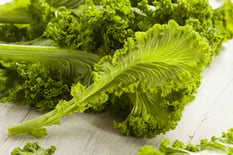By Cynthia Green, RDN, LD, IBCLC
Mustard greens, thought to have originated in India, have been consumed for over 5000 years and are grown from the tiny mustard seed. As a cool-season crop, they are frequently grown in cooler climates and can withstand a light freeze such as those common during winters in the southern United States.
Having a pungent, peppery, spicy-hot bite, mustard greens are enjoyed in many cuisines around the world. Though varieties of the mustard green family can differ in appearance, they all have a similar punch of flavor, which can be offset by braising them or by serving them with whole grains or naturally sweet ingredients, such as caramelized onions.

The cruciferous mustard greens belong to the Brassica family, which includes cabbage, cauliflower, and broccoli. In addition to the more common green variety, mustard “greens” can also be brown, black, purple, or red. These vibrantly colored variations are becoming more readily available in specialty grocery stores, and while they may vary in color, the mustard flavor is still present.
Nutritional Benefits
Mustard greens are low in calories and loaded with nutrients. They’re an especially excellent source of vitamins A, C, and K as well as copper, manganese, and calcium. According to USDA Food Data Central, mustard greens are also a good source of dietary fiber, phosphorus, folic acid, potassium, zinc, selenium, magnesium, iron, and vitamins B6 and B2.
In addition to vitamins and minerals, mustard greens are packed with protective nutrients, called phytonutrients, that are naturally produced by plants. Studies show that routine consumption of phytonutrients can boost your body’s immune system to help us fight off disease.
How to Enjoy
To find mustard greens, check out your local farmers market during the spring and fall. Look for leaves that are bright green—or one of the other vibrant colors listed above—that don’t have any yellowing or wilting. Stems should look freshly cut and not dried out, brown, or split. If you’re looking for mustard greens out of season, check your grocery store’s frozen vegetable section.
If greens are purchased in a bunch, remove the ties and store them loosely in the higher humidity section of the refrigerator bins. Mustard greens that are bought fresh and kept in a controlled temperature should last for five days.
Mustard greens are flavorful and full of nutrients. Try some of the following tips to incorporate them into your diet:
-
• If you like spicy salad greens, use raw young mustard green leaves or chopped larger greens as a salad base.
-
• Combine the mustard greens with other greens, such as spinach or kale, to add a more subtle mustard flavor to your salad base.
-
• To mellow the flavor, cook the leaves with something sweet, such as honey.
-
• Combine mustard greens with collard greens, swiss chard, or any other greens to help reduce the spicy flavor. Serve as a base under your protein on the plate for a restaurant-quality dish.
-
• In the South, mustard greens are frequently sautéed with bacon, onion, and broth. Cook until the greens are fall-apart tender.
-
• As an alternative to bacon, cook with a piece of smoked turkey or leave out the meat altogether and sauté with onions, garlic, and vegetable broth.
-
• Add a splash of leftover coffee into the greens to bring out another depth of flavor.


.png?width=1278&name=HHS-company%20logo-final%20(1).png)